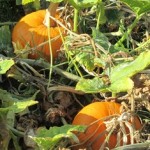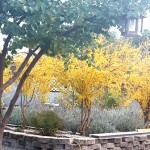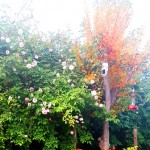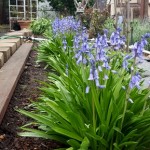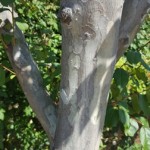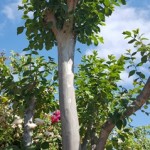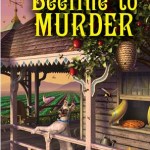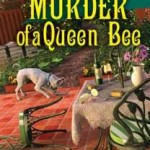Celebrate the Ever-Evolving Garden
There’s nothing to rejuvenate a weary soul like time spent in a garden. Death of one season’s plants yields to new shoots the next. Because I appreciate the ever-evolving nature of a garden, I choose plants, bulbs, bushes, and trees that offer visual interest in each season. Thoughtful planting generates an ever-evolving landscape of color, texture, and visual interest.
The autumn garden has almost completely morphed into a winter landscape now. Pumpkin and tomato vines have been pulled out and perennials in the bee garden have gone to seed or been cut back. Winter offers little color in the garden except for the cape honeysuckle, white geranium, lavender florets, and early flowering bulbs.
Deciduous trees have mostly lost their leaves, however, the eucalyptus and the pepper trees here on the farmette remain leafy and green. The rains have come and a dusting of snow on nearby mountain peaks is in the forecast ahead. Foliage and blooms are mostly gone. It’s that time of year to cover frost-sensitive plants.
The pomegranates that were ablaze in golden color a few weeks ago have dropped all leaves. What remains is the lovely arching pattern of branches since I’ve trained them from bushes into trees.
The showy pink flowers over summer of the crape myrtle are a memory. Gone now, too, are the red-gold leaves of fall. What remains is an interesting gray-green bark.
The seeds from the giant yellow-orange coreopsis that stood eight feet tall and towered over zinnias, Borage, and rows of lavender have long ago been harvested. Also, my patch of lavender is flourishing. The plants have pushed out long stalks of purple florets.
Dark green shoots of bulbs are pushing up out of the earth where I interplanted them with chrysanthemums. I cut back the mums and they will reappear in the spring to flower again. This is the time of year that shoots of bulbs and rhizomes are birthing daffodils, anemones, tulips, hyacinths, and, to come later, lilies and irises of many colors.
In raised beds, shoots of fall-planted onions and garlic are now pushing up. The bees are drawn to the sweet scent of narcissus bulbs that have naturalized after being planted years ago. The Meyer lemon now has lots of yellow thin-skinned fruit and also a few early blooms.
On the dark days and nights of winter, white blooming plants stand in stark contrast to gray wooden fences and leafless trees. Honor roses, Iceberg roses, and climbing Sally Holmes roses have showy white blooms and may even have some this time of year unless they’ve been cut back. Winter-blooming gardenias and white geraniums have a quiet impact when grouped together in hedges, beds, or containers.
With so many bulbs and plants available this time of year, putting interest into your winter garden is easy and contributes to an ever-evolving landscape.
Consider plants with gray-green or otherwise pretty foliage and colorful berries. Also plant trees with interesting bark colors, textures, patterns, or scaffolding shapes. When you think of plants for each season of the year, you’ll have a garden to nurture you throughout the year.
____________________________________________________
If you enjoy reading about gardening, the keeping of chickens and bees, and other small farm topics AND you’d like related gift-giving, consider my Henny Penny Farmette series of cozy mysteries or any of my health, wellness, and spirituality books. All are available online and in traditional bookstores everywhere.
AVAILABLE NOW. Tap control click in the following link: https://www.amazon.com/How-Live-Intention-Meaning-Purpose-ebook/dp/B07GNVFWSF/ref=sr_1_1?ie=UTF8&qid=1544206797&sr=8-1&keywords=Meera+Lester%2BHow+to+Live+with+Intention
To Purchase, tap control click on the link:
Transplanting a Decades-Old Crape Myrtle Tree
Friends said it was a bad idea. The tree was too large, too old, and too unwieldy to dig up and transport from my daughter’s property to mine. The crape myrtle would not survive, they told me, because its large root would need to be severely cut. Also, without a crane or other lifting device, three of us would be struggling to deal with such a heavy tree.
I won’t say moving the tree was easy. It had been standing for 28 years next to my daughter’s house, but she wanted to make way for new landscaping. When the family decided to part with the tree, they called on a family friend who worked as an arborist. He would do the cutting and digging of the tree.
Crape myrtles (of the genus, lagerstoemia) are available as shrubs and trees and are lovely in bloom with showy paniculate flowers in pink, fuchsia, red, or lavender. They are one of the trees that make little-to-no pollen (great for allergy sufferers). Light pruning during the growing season can produce a second bloom. Much beloved in the deep south, these trees remain stately and beautiful for up to fifty years.
My daughter’s tree arrived at the farmette in mid-October strapped onto our friend’s truck. The roots had been cut away. There were no fine root hairs or stems left–just bare wood. Ditto for the tree canopy–just a few hefty branch stubs. I wondered if our efforts would prove futile.
Hubby and I prepared a large planting hole just off from the patio. We added amendments to the clay soil and drove in stakes to keep the tree stable for a year or more until it had sufficiently developed roots. I added root hormone to the soil and watered deeply the first day and several times that week.
The winter rains came. I watched, waited, and wondered if there would ever be sprouting of any kind on the woody ends where branches had been amputated. Despite a canopy, the tree’s trunk, a beautiful, gray-green wood, afforded a kind of beauty to the austere winter garden. Before spring, I scraped a fingernail on the back of the trunk and discovered the wood was not dried out but as green and moist as a young sapling.
A spell of warm weather and the buzzing of bees in early spring drew my attention upward. Our tree had sprouted a flurry of bronze-green leaves. Pink blooms will likely appear in June or July.
I’m happy now that we went to all the trouble of bringing that tree onto the farmette for transplanting. We’ll have lovely pink blooms over the remaining summers of my life thanks to the crape myrtle tree being so long-lived.
__________________________________________________________________
If you enjoy reading about gardening and farming topics, check out my Henny Penny Farmette series of mysteries: A BEELINE TO MURDER, THE MURDER OF A QUEEN BEE, and A HIVE OF HOMICIDES (Kensington Publishing).
Each book is chocked full of tips for gardening, keeping bees and chickens, and growing heirloom fruits and vegetables. There are also plenty of delicious recipes to try. Find these books on Amazon.com, Barnes & Noble.com, Walmart.com and other online retailers or purchase at traditional bookstores everywhere.–Meera Lester
 Facebook
Facebook Goodreads
Goodreads LinkedIn
LinkedIn Meera Lester
Meera Lester Twitter
Twitter




